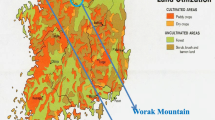Abstract
Emissions of hexanal, heptanal, octanal, nonanal, and decanal from 6 different plant species were measured in continuously stirred tank reactors when the plants were exposed to ozone. Pathogen- and insect attack on plants also led to these emissions. The emission rates of individual aldehydes were related to each other implying a common mechanism for the emissions of these aldehydes. Furthermore, the emission pattern was similar in all cases indicating a similar emission mechanism for different plant species and different elicitors. Measurements with ozone exposed Scots pine plants (Pinus sylvestris L.) showed that the emission rates were dependent on temperature as well as on the ozone flux into the plants. The diurnal variation of aldehyde emissions from ozone exposed Scots pine were described quite well using a formalism including temperature and ozone flux as variables. Assuming the aldehyde emissions to be general for plants exposed to ozone, the global emissions were estimated to be in the range between 7 and 22 Tg/a. Because these emissions can be induced by other factors than ozone uptake alone this estimate may be a lower limit.
Similar content being viewed by others
References
Buttery, R. G., Kamm, J. A., and Ling, L. C., 1982a: Volatile components of alfalfa flowers and pods, J. Agric. Food Chem. 30, 739–742.
Buttery, R. G., Ling, L. C., and Wellso, S. G., 1982b: Oat leaf volatiles: Possible insect attractants, J. Agric. Food Chem. 30, 791–792.
Buttery, R. G., Xu, C., and Ling, L. C., 1985: Volatile components of wheat leaves (and stems): Possible insect attractants, J. Agric. Food Chem. 33, 115–117.
Cao, X. L. and Hewitt, C. N., 1994: Study of the degradation by ozone of adsorbents and of hydrocarbons adsorbed during the passive sampling of air, Environ. Sci. Technol. 28, 757–762.
Chameides, W. L., 1989: The chemistry of ozone deposition to plant leaves: Role of ascorbic acid, Environ. Sci. Technol. 23, 829–831.
Ciccioli, P., Brancaleoni, E., Frattoni, M., Cecinato, A., and Brachetti, A., 1993: Ubiquitous occurrence of semi-volatile carbonyl compounds in tropospheric samples and their possible sources, Atmos. Environ. 27A, 1891–1901.
Guenther, A. B., Zimmerman, P. R., Harley, P. C., Monson, R. K., and Fall, R., 1993: Isoprene and monoterpene emission rate variability: Model evaluation and sensitivity analyses, J. Geophys. Res. 98, 12,609–12,617.
Helmig, D. and Greenberg, J. P., 1994: Automated in situ gas chromatographic-mass spectrometric analysis of ppt level volatile organic trace gases using multistage solidadsorbent trapping, J. Chromatogr. A 667, 123–132.
Helmig, D., Pollock, W., Greenberg, J., and Zimmerman, P., 1996: Gas chromatography mass spectrometry analysis of volatile organic trace gases at Mauna Loa Observatory, Hawaii, J. Geophys. Res. 101, 14,697–14,710.
Jüttner, F. and Bufler, U., 1988: Physiologische und biochemische Prozesse der Terpen-Emission in Picea abies, in PEF (ed.), Projekt Europäisches Forschungszentrum für Maßnahmen der Luftreinhaltung, KFK-PEF 35 Karlsruhe, pp. 197–207.
Kesselmeier, J. and Staudt, M., 1999: Biogenic organic compounds (VOC): An overview on emission, physiology and ecology, J. Atmos. Chem. 33, 23–88.
Kirstine, W., Galbally, I., Ye, Y., and Hooper, M., 1998: Emissions of volatile organic compounds (primarily oxygenated species) from pasture, J. Geophys. Res. 103(D9), 10,605–10,619.
Komenda, M. and Koppmann R., 2002: Monoterpene emissions from Scots pine (pinus sylvestris): Field studies of emission rate variabilities, J. Geophys. Res., in press.
König, G., Brunda, M., Puxbaum, H., Hewitt, C. N., Duckham, C., and Rudolph, J., 1995: Relative contribution of oxygenated hydrocarbons to the total biogenic VOC emissions of selected Mid-European agricultural and natural plant species, Atmos. Environ. 29, 861–874.
Latrasse, A., Semon, E., and Le Quere, J. L., 1991: Composition and major odorous compounds of the essential oil of Bifora radians, an aldehyde-producing weed, J. High Resolution Chrom. 14, 549–553.
Neubert, A., Kley, D., Wildt, J., Segschneider, H. J., and Förstel, H., 1993: Uptake of NO, NO2 and O3 by sunflower and tobacco: Dependence on stomatal conductivity, Atmos. Environ. 27A, 2137–2145.
Owen, S., Boissard, C., Street, R. A., Duckham, C., Csiky, O., and Hewitt, C. N., 1997: Screening of 18 Mediterranean plant species for volatile organic compound emissions, Atmos. Environ. 31(SI), 101–118.
Schuh, G., Heiden, A. C., Hoffmann, T., Kahl, J., Rudolph, J., and Wildt, J., 1997: Emission of volatile organic compounds from sunflower and beech: Dependence on temperature and light intensity, J. Atmos. Chem. 27, 291–318.
Staudt, M., Bertin, N., Frenzel, B., and Seuffert G., 2000: Seasonal variation in amount and composition of monoterpenes emitted by young pinus pinea trees - implications for emission modeling, J. Atmos. Chem. 35, 77–99.
Tingey, D. T., Turner, D. P., and Weber, J. A., 1991: Factors controlling the emissions of monoterpenes and other volatile organic compounds, in T. D. Sharkey, E. A. Holland, and H. A. Mooney (eds), Trace Gas Emissions by Plants, Academic Press, San Diego, pp. 93–119.
Yokouchi, Y., Mukai, H., Nakajima K., and Ambe, Y., 1990: Semi-volatile aldehydes as predominant organic gases in remote areas, Atmos. Environ. 24A, 439–442.
Wojtasek, P., 1997: Oxidative burst: An early plant response to pathogen infection, Biochem. J. 322, 681–692.
Author information
Authors and Affiliations
Additional information
Now at
Now at
Rights and permissions
About this article
Cite this article
Wildt, J., Kobel, K., Schuh-Thomas, G. et al. Emissions of Oxygenated Volatile Organic Compounds from Plants Part II: Emissions of Saturated Aldehydes. Journal of Atmospheric Chemistry 45, 173–196 (2003). https://doi.org/10.1023/A:1024030821349
Issue Date:
DOI: https://doi.org/10.1023/A:1024030821349




